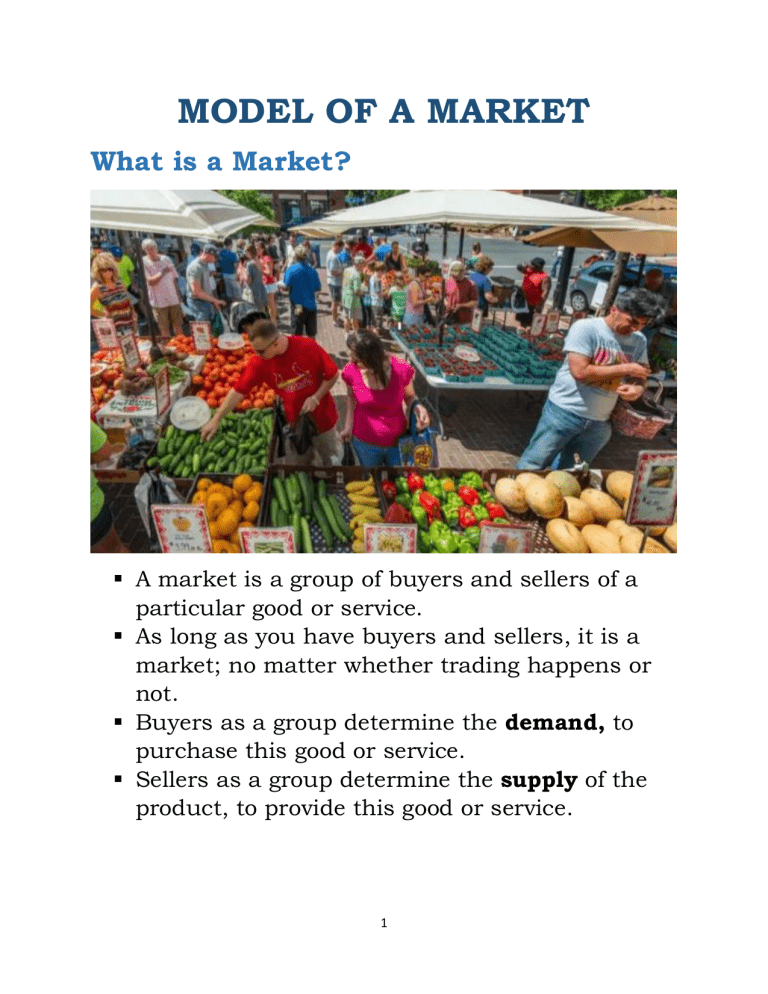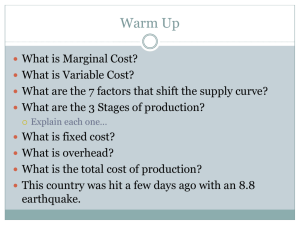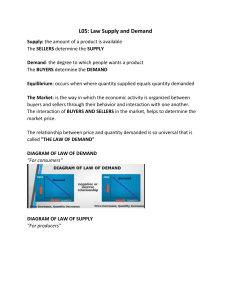
MODEL OF A MARKET What is a Market? A market is a group of buyers and sellers of a particular good or service. As long as you have buyers and sellers, it is a market; no matter whether trading happens or not. Buyers as a group determine the demand, to purchase this good or service. Sellers as a group determine the supply of the product, to provide this good or service. 1 Supply Much of the logic for demand also applies to the supply side of the market. The quantity supplied is the amount of a product that firms are willing and able to sell. A number of factors affect the decision of the sellers: • the price of the product. • the wage paid to workers. • the price of materials. • the cost of capital. • the state of production technology. • expectations about future prices. • government taxes and subsidies. Supply curve shows as a curve showing the relationship between price and quantity supplied. The law of supply states that there is a positive relationship between price and quantity supplied. This is true of both the individual supply curve, which shows the relationship between price and quantity supplied by an individual firm, and the market supply curve, which shows the relationship between price and quantity supplied by all firms. As output increases, the cost of producing each additional unit increases. This leads to an upward sloping supply curve. 2 price per unit of the good quantity ) is the quantity demanded supply set *( and is the unit price } We shall linearize the general situation. ( ) ( ) ( ) ; p is the independent variable Demand The quantity demanded of a particular good is the amount of a product that consumers are willing and able to buy. A number of factors affect how much of a good a consumer wants to purchase: 3 • the price of the product. • the consumer’s income. • the price of substitute goods. • the price of complementary goods. • the consumer’s preferences or tastes. • the consumer’s expectations of future prices. Demand shows the relationship between the price of a product and the quantity demanded of that product. When we talk about a demand schedule, we assume that all of the other factors listed above (tastes, income, etc.) are held constant and only the price of the good changes. The demand curve is a graphical representation of the demand schedule. The curve shows the relationship between the price of a good and the quantity demanded of that good. An individual demand curve shows the relationship between the price of a good and the quantity demanded by an individual consumer. A market demand curve shows the relationship between price and quantity demanded by all consumers. 4 price per unit of the good quantity ) demand set *( and is the unit price } is the quantity demand We shall linearize the general situation. ( ) ( ) ( ) ; p is the independent variable Equilibrium We have seen that at each price, the quantity demanded tells us how many units buyers are willing to buy and the quantity supplied tells us how 5 many units sellers are willing to sell. Market equilibrium occurs at the price where the quantity demanded is equal to the quantity supplied. The price at which this occurs is called the equilibrium price because it is the price that balances the quantity demanded and the quantity supplied. At this price, buyers are buying all the goods they desire, sellers are selling all the goods they desire, and there is no pressure for the market price to change. At the equilibrium point, Supply quantity ( ) demand quantity ( ) ( ) 6 ( ) At prices other than the equilibrium there is an imbalance between the quantity supplied and the quantity demanded. Excess Supply Suppliers are willing to sell more than demanders wish to purchase at those prices. This is known as an excess supply or surplus, a situation in which the quantity supplied exceeds the quantity demanded at the prevailing price. A price floor (prices held above equilibrium by law) will create excess supply in the affected market. Excess supply Supply Demand Excess Demand Buyers want to buy more than sellers want to sell. This situation is known as excess demand, or a shortage, a situation where the quantity demanded exceeds the quantity supplied at the prevailing price. In a situation of excess demand, the price for a good will increase, causing the quantity demanded to fall and the quantity supplied to rise until they are in equilibrium. Excess Demand Demand 7 Supply Example: Supply function; ( ) Demand function; ( ) In the equilibrium state; ( ) ( ) 8 Excess Supply ( ) ( Excess Demand ; ) , Exercise: Supply function; Demand function; Find, each of the following: ( ) I. II. ( ), III. , IV. , V. Excess supply, VI. Excess demand. Must do the home work and submit to the Tutor (sachinia@pdn.ac.lk). Note. This is a nonlinear situation and is given by the quadratic = only answer is, because negative answer is not valid. Thus the equilibrium price is = 7. Interpret your results graphically. 9








